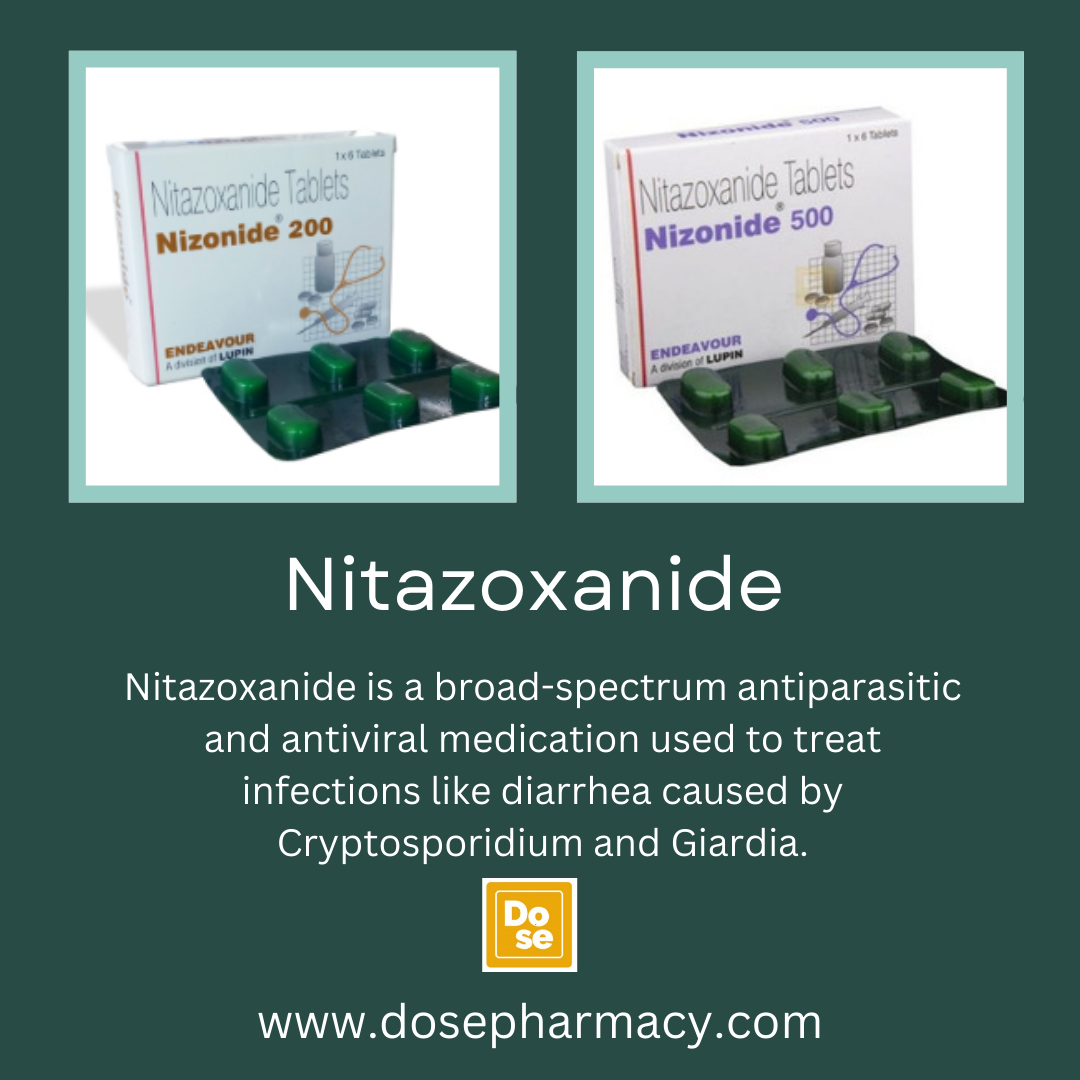Nitazoxanide 500 mg is a broad-spectrum antiparasitic and antiviral medication primarily used to treat intestinal infections such as diarrhea caused by Giardia lamblia and Cryptosporidium parvum. It is also studied for various viral infections like rotavirus, norovirus, and even influenza. Understanding the correct dosage is crucial for ensuring the drug’s effectiveness while minimizing side effects, especially in different age groups.
This guide explains the appropriate dosage of nitazoxanide for both adults and children, how to take it, possible side effects, and important safety tips.
🔹 What Is Nitazoxanide?
Nitazoxanide 200 mg is an antiparasitic and antiviral medication available in tablet and oral suspension forms. It is most commonly prescribed for:
- Diarrhea caused by Giardia lamblia or Cryptosporidium parvum
- Rotavirus and norovirus infections
- Potential off-label uses like influenza, hepatitis B and C, and COVID-19 (under investigation)
It is sold under brand names like Alinia in the United States and Nizonide in many countries.
🔹 How Nitazoxanide Works
Once ingested, nitazoxanide is rapidly converted into its active form, tizoxanide, in the body. Tizoxanide works by interfering with the energy production system of parasites and some viruses, effectively stopping their growth and spread.
🧾 Nitazoxanide Dosage Guide
The dosage of nitazoxanide depends on the patient’s age, weight, and the type of infection. Below is a general guide.
1. Nitazoxanide Dosage for Adults (Ages 12 and older)
For treatment of diarrhea caused by Giardia lamblia or Cryptosporidium parvum:
- Dose: 500 mg orally every 12 hours
- Duration: 3 days
- Form: Tablet (each contains 500 mg of nitazoxanide)
How to take it:
- Take with food to improve absorption
- Swallow the tablet whole with a glass of water
2. Nitazoxanide Dosage for Children (1 to 11 years)
Children are usually prescribed oral suspension (liquid form), which contains 100 mg per 5 mL.
a. Children 4 to 11 years
- Dose: 200 mg (10 mL) every 12 hours
- Duration: 3 days
b. Children 1 to 3 years
- Dose: 100 mg (5 mL) every 12 hours
- Duration: 3 days
Tips for caregivers:
- Shake the suspension well before each dose
- Use a proper measuring device, not a kitchen spoon
- Give the medicine with food for better effectiveness
3. Infants (Under 12 months)
Nitazoxanide is not recommended for infants under 12 months due to limited safety and efficacy data. Always consult a pediatrician before considering this treatment for babies.
⚠️ Dosage in Special Conditions
While nitazoxanide is generally safe, certain groups may require special consideration:
Renal or Hepatic Impairment
- There is limited data, so dose adjustments should be made cautiously
- Always consult a healthcare provider before use
Elderly Patients
- Use with caution; monitor for side effects
- No specific dose adjustments unless there are underlying conditions
💡 Administration Tips
- With Food: Nitazoxanide should always be taken with meals to enhance absorption and minimize stomach upset.
- Missed Dose: If a dose is missed, take it as soon as you remember unless it’s near the time for the next dose. Do not double the dose.
- Duration: Complete the full course even if symptoms improve early to avoid reinfection or resistance.
❗Side Effects to Watch For
Nitazoxanide is generally well-tolerated. However, like any medication, it may cause side effects. Most are mild and temporary.
Common Side Effects:
- Nausea
- Vomiting
- Abdominal pain
- Headache
- Discolored urine (yellow-green) — harmless and reversible
Rare but Serious Side Effects:
- Allergic reactions (rash, itching, swelling)
- Severe dizziness
- Breathing difficulties
Seek medical help immediately if any serious symptoms occur.
🔄 Drug Interactions
Nitazoxanide has few known drug interactions but may interact with:
- Warfarin (blood thinner): May increase bleeding risk
- Antiviral medications or immunosuppressants: Caution is advised
- Alcohol: Avoid alcohol during treatment, as it may increase side effects
Always inform your doctor about any medications or supplements you are taking.
📦 Storage and Shelf Life
- Tablets: Store at room temperature, away from moisture and heat
- Suspension: Once reconstituted, the liquid should be used within 7 days
- Keep out of reach of children
❓Frequently Asked Questions (FAQs)
Q1: Can nitazoxanide be used for viral infections?
Yes, it has shown activity against several viruses like rotavirus, norovirus, influenza, and hepatitis viruses. However, use for viral infections is typically off-label and under clinical research.
Q2: Is it safe during pregnancy or breastfeeding?
Use only if clearly needed and prescribed by a doctor. There is limited safety data for pregnant or breastfeeding women.
Q3: What if symptoms don’t improve after 3 days?
Consult a doctor. A different medication or longer treatment may be needed depending on the infection.
Nitazoxanide is a versatile and effective medication for treating parasitic and some viral gastrointestinal infections. Proper dosing is essential for successful treatment and varies depending on age and weight. Adults typically take 500 mg twice daily, while children receive weight-based doses in suspension form.
Always follow your healthcare provider’s instructions, complete the full course, and watch for any unusual side effects. With the correct dosage and care, nitazoxanide can offer quick relief from persistent infections.
